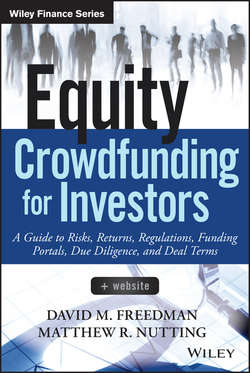Читать книгу Equity Crowdfunding for Investors - Matthew R. Nutting - Страница 8
На сайте Литреса книга снята с продажи.
Preface: The New Angel Investors
The Game Changer
ОглавлениеThe rules changed radically in 2012 when Congress unlocked that door to angel investing and lifted the ban on general solicitation. The Jumpstart Our Business Startups (JOBS) Act, signed by President Barack Obama on April 5, 2012, aimed to give small companies a boost by making it easier for them to raise capital. Title III of the JOBS Act created an exemption to the registration requirements of the Securities Act of 1933 to allow startups and growing businesses to sell equity to all investors, not just accredited ones, through online crowdfunding portals. This “crowdfunding exemption” was codified as Section 4(a)(6) of the Securities Act. The concept of registration and exemption can be confusing, so we will clear it up in Chapter 2.
In 2015, the Securities and Exchange Commission, alongside the Financial Industry Regulatory Authority, are expected to issue rules for the operation of equity crowdfunding portals, swinging the door to online angel investing wide open. The SEC and FINRA will continue to regulate equity crowdfunding, adjusting the rules and attempting to police the system against any fraud.
The new Section 4(a)(6) of the Securities Act limits the amount of capital that a company can raise via equity crowdfunding to $1 million per year,4 and it limits the amount of money that nonaccredited investors can invest based on their net worth or income, to make sure nobody goes broke via crowdfunding. (We will describe these limits in detail in Chapter 3.) But it does not limit the number of investors to whom a company can sell shares via a funding portal. Whereas traditional angel deals typically required investors to put up tens or hundreds of thousands of dollars apiece just to walk in the door, equity crowdfunding investors may be able to buy shares for as little as $1,000 and perhaps less. So companies that issue shares on crowdfunding portals or through broker-dealers, based on Section 4(a)(6), can expect to receive many smaller investments from a much larger number of investors. This essentially turns the traditional angel deal on its head: from a small group of large-dollar-amount investors to a big group – a crowd – of small-dollar-amount investors.
If 268,000 angel investors funded startups and early-stage companies in 2012, when such deals were effectively restricted to a tiny segment of the population, now that those restrictions have been lifted there is no telling how many more investors will participate in the angel capital market. We can be a nation of angel investors, boosting opportunities for entrepreneurs to raise capital, hire employees, and pay taxes – not just in the metropolitan areas and high-tech corridors where angel capital tends to cluster, but everywhere.
4
Some members of the House of Representatives have proposed increasing the capital-raise limit to as much as $5 million.
